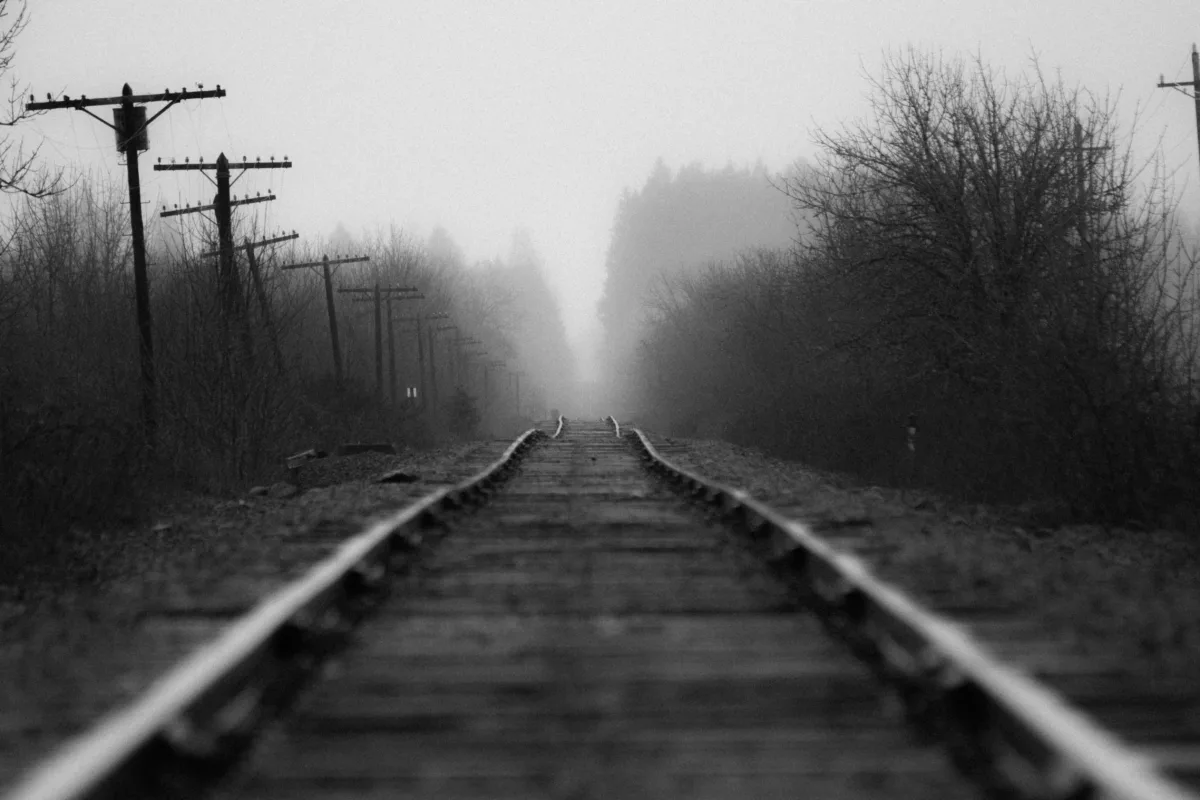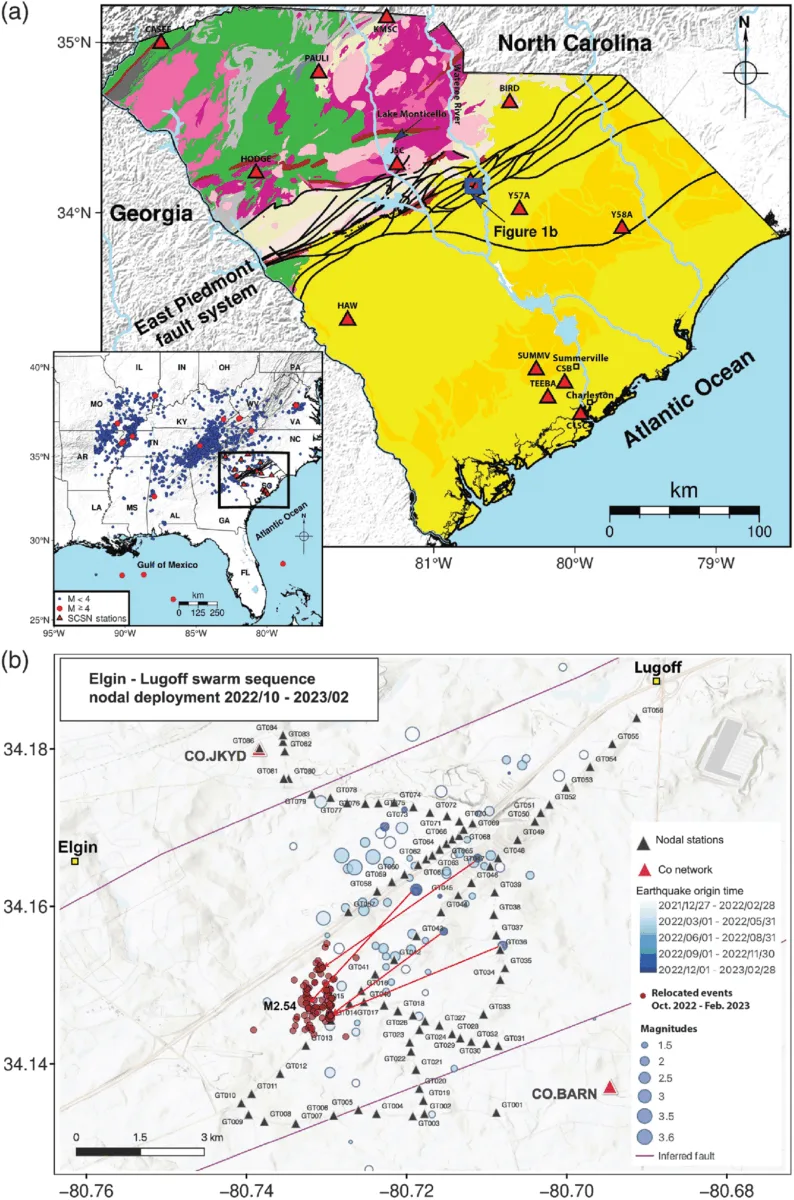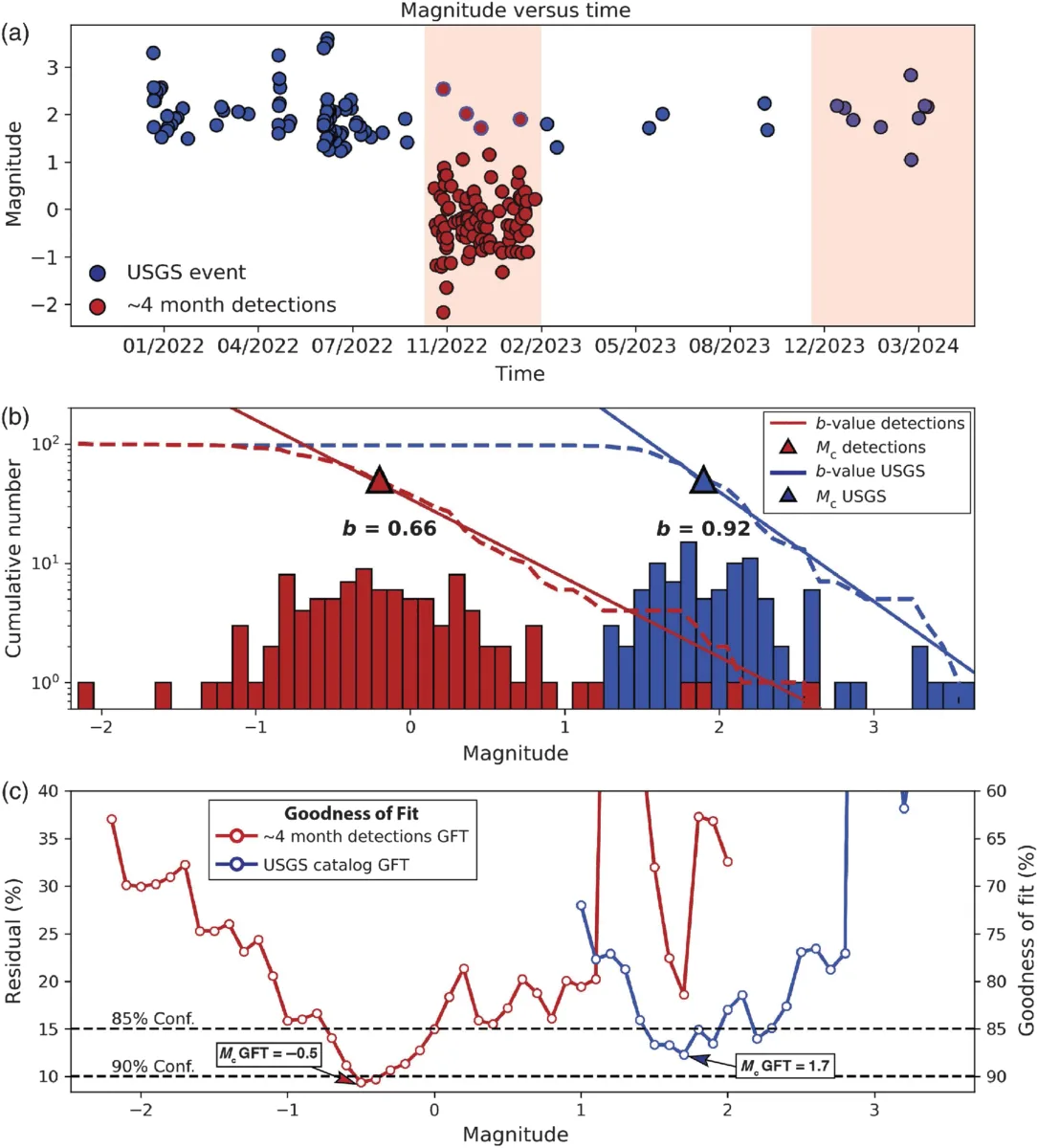
Once upon a time, a devoted wife waited for her husband by the railroad tracks. Tragically, they were not to reunite.
The wife learned that her husband had been decapitated in a train-related accident, his head never found. For the rest of her life, the wife took her lantern to the tracks, searching for her husband’s remains. As the tale goes, even after her death, she continued her quest, thus accounting for curious flashing lights observed along a place now called Old Light Road near Summerville, South Carolina.
This is one version of a ghost story meant to explain the Summerville Light—small sphere-like twinkles seen at a distance by intrepid visitors, sometimes accompanied by reports of audible voices, moving doors or objects, shaking cars, or even ghostly apparitions.
A new paper published in Seismological Research Letters by USGS scientist Susan Hough posits that these curious phenomena might be related to earthquakes. Hough points to another paper, also published in Seismological Research Letters, led by doctoral student Oluwaseyifunmi Adeboboye of Georgia Tech, as a potential analog: an earthquake swarm near the historically low-seismicity region of Elgin, South Carolina may bear similarities to the proposed seismicity that could explain the Summerville Light.
Earthquake lights and other incidents
“Some earthquake effects lend themselves to supernatural interpretation,” Hough says. The seemingly supernatural phenomena reported in the Summerville area, then, may have rational, natural explanations that all come down to seismology.
For instance, violently shaking cars can easily result from localized, shallow earthquakes. The reported balls of light could be something called earthquake lights. This poorly understood phenomenon could be explained when the release of gas from Earth’s innards—with or without earthquakes—ignites when exposed to oxygen and a spark of static electricity.
What about mysterious footsteps, or doors slamming when no one else is there? Hough again points to earthquakes, but ones with low intensity. The intensity of earthquake shaking is characterized by the Modified Mercalli Intensity (MMI) scale. An earthquake of MMI 2 is “felt only by a few persons at rest, especially on upper floors of buildings,” according to the USGS. Hough adds that hanging objects like doors may swing, and people may experience dizziness or nausea. Even animals can be disturbed.
One home in Summerville, known as “This Whole House”, has been the center of (and leaned into) much of the seemingly inexplicable—doors slamming, objects moving, and other curiosities. This “rambling” home is older, and MMI 2 levels of shaking may seem more pronounced than in newer structures. This Whole House also hosts unaccountable noises. These sounds could be conflated with high-frequency shaking at the threshold of human perceptibility, according to Hough.
And finally, although the sightings of ghosts cannot be directly explained via earthquakes, there’s a possibility that people are hallucinating by breathing in certain gases released by seismic shifts in the shallow Earth. Such gases may account for the famous Oracle at Delphi (now in modern-day Greece), best known as prophesying priestess. For at least a millennium, the designated oracle would breathe in vapors to enter a trance-like state, and then answer questions put to her by a priest. As far as we know, no one has reported both ghosts and hallucinating in Summerville, but this explanation remains an interesting possibility.
Were there earthquakes in Summerville?
Although Hough’s earthquake-based explanations for the Summerville Light and its ghosts seem plausible, one might wonder: Are there actually earthquakes in this region? South Carolina isn’t especially seismically active at the moment, but in 1886, the Charleston earthquake—an intraplate event of estimated magnitude 7—struck not far from Summerville, causing death and destruction in and around Charleston.
The Comprehensive Earthquake Catalog, known as ComCat, includes two earthquakes in the Summerville area between 1890 and 1960. News accounts of the first, an estimated magnitude 3.9 earthquake that occurred in 1907, suggest more severe effects in Summerville than Charleston. The second event, an estimated magnitude 4.4 earthquake in 1959, was widely felt, with reports suggesting, yet again, more severe shaking in Summerville. Two other earthquakes occurred in the region in 1960.
Reports of the Summerville light began some time after that. “The timeline is a bit vague,” Hough says. “Faults start rumbling, lights are generated, people start telling ghost stories, all within a couple of years.”
Although there are no reports of aftershocks, it’s likely that the earthquakes recorded in ComCat produced smaller quakes that may have gone undetected. In eastern North America, mainshock earthquakes tend to have relatively light aftershock sequences, says Hough. Because no seismometers were around in the 1960s to pick up any subtle shakes, only felt reports could help with picking out subsequent quakes.
Today, however, seismologists can pick up unimaginably small tremblings within Earth’s crust. But bigger earthquakes hint at where they should start looking for tiny temblors.
Today’s Elgin-Lugoff Swarm in South Carolina
Between the South Carolinian towns of Elgin and Lugoff, an earthquake swarm began in December of 2021 that is still active today, according to Adeboboye. This is an area with low seismicity, yet since the swarm began, the USGS has reported nearly 100 small-magnitude earthquakes. Hough points to this swarm—specifically its persistent concentration of seismicity—as a possible modern analog to what happened in Summerville.

To explore the Elgin swarm in more detail, Adeboboye and colleagues deployed 86 nodal seismometers for four months, from October 2022 to February 2023. These data will soon be accessible via the NSF SAGE archive. Over those four months, the deployment collected data from up to 100 microearthquakes. Compare that with the four events listed in the USGS catalog for the same four-month span. “By lowering the detection threshold, we can begin to capture these smaller events,” Adeboboye says.
He and his colleagues used deep learning and filter matching techniques, as well as updated relocation methods for more precise earthquake locations. This new catalog of earthquakes outlined a north-south striking fault plane that dips to the west. “Such faults are oriented for reactivation under the ENE-WSW compressive stress field in the Southeastern U.S.,” says Adeboboye. In other words, this is likely an old structure—on the order of hundreds of millions of years old—that’s slowly moving again, now with strike-slip motion.

However, Elgin-Lugoff is not a perfect analog. For one, there are no ghost stories that we know of.
But Adeboboye points out that Summerville’s seismicity appears to follow the foreshock-mainshock-aftershock pattern, with the mainshock being the 1886 event. The Elgin-Lugoff swarm may instead be driven by fluid migration or aseismic slip, he says.
In the Summerville and Charleston area, Hough says “there are accounts of strong sulfur smells… in some cases associated with earthquakes.” That’s not the case in Elgin. To really compare the tectonics and associated seismicity of the two regions, “we really just need more data,” she says.
Ghost stories
Sudden onset of seismicity may elicit supernatural explanations, both now and in the past. And so, in regions with no societal memory of earthquakes, could ghost stories provide clues for seismologists about where to look for microseismicity?
Hough considers a similar ghost story from Maco, North Carolina. Here, the ghost of railroad worker Joe Baldwin haunts the railroad track where he was hit and decapitated by a train in the 1860s. The headless ghost is supposedly searching for his own head with a lantern (yes, you read that right). Between 1886 and now, 43 earthquakes have been detected in this region, as reported in the CEUS-SSC earthquake catalog.
Maco’s headless ghost may be analogous to the Summerville Light because of the remote region, shallow earthquakes, possible gas release, and the coincidence of railroad tracks. “My thoughts ran to sparks generated by steel tracks or discarded steel, but long steel rails could play another role with an electromagnetic phenomenon,” Hough says when considering the parallels between Maco and Summerville.
Other stories similar to Maco’s ghost and the Summerville Light include the Brown Mountain Light in western North Carolina and the Gurdon Light in Arkansas. “I don’t suggest that earthquake lights are generated along every shallow or potentially active fault,” she says, “but where they exist, ghosts may be telling us where to look.”
Such work is societally important. When regions of low seismicity are unexpectedly hit by earthquakes, the aftermath could be catastrophic. “It’s an ‘unknown unknown’ problem,” Hough says, pointing to evidence suggesting there are potential seismic sources along the East Coast of the U.S. other than the ones that have produced major historic earthquakes, like the 1886 Charleston event. “There’s so much we don’t know about earthquakes in the east,” Hough says. Had the 1886 Charleston earthquake occurred, say, 400 years earlier, little beyond the elevated level of small earthquakes would be left.
Paleoseismology can help, too, says Adeboboye. “Even if a region appears quiet today, a history of major seismic events suggests that the faults were active in the past, and hence are potentially capable of producing damaging earthquakes.”
Seismologists wouldn’t be shocked should a moderate-to-large magnitude event strike near major cities like New York, Boston, or even Chicago, says Hough. “But they sure would shock people and potentially cause massive damage.” “Focused investigations like the work in Elgin can potentially give us important new clues about earthquake processes and hazard in the east,” Hough says. “Maybe friendly ghosts can help too.”

